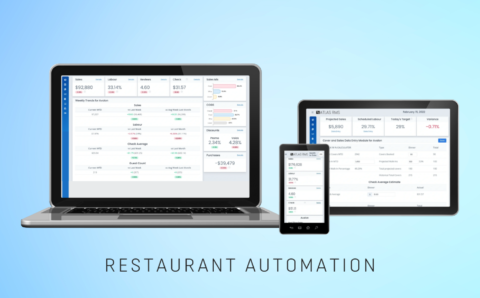
Software development outsourcing is a widely adopted strategy for businesses striving to optimize their resources, skyrocket time-to-market, and gain access to narrow, domain-specific expertise, decreasing the hiring process as well. The IT outsourcing market is forecasted to achieve a revenue milestone of $512.50 billion this year. In the following 4 years, the sector is projected to have a market volume of US$777.70 billion, with a compound annual growth rate (CAGR) of 10.99%.
Outsourcing is the practice of delegating particular tasks or entire projects to external vendors or offshore teams. As a forward-thinking entrepreneur, you should be aware of the trends of IT outsourcing not only to make relevant business decisions about outsourcing partners but also to smoothly adapt these strategies and maximize the benefits of outsourcing cooperations.
In this article, we’ll explore eight core software development outsourcing trends that are predominant in the current market. Let’s define the factors impacting outsourcing decisions and provide insights into how organizations can implement these trends to accelerate innovation, set new value streams, and achieve their objectives.
Table of Contents:
The Evolution of Software Development Outsourcing
Those businesses relying solely on in-house resources to address their operational demands may face restricted scalability, operational costs going through the ceiling, and decreased access to specialized competence since they spend too much on building and maintaining internal teams and infrastructure to support their business process and projects.
Historical Context: Origins and Early Practices
The software development outsourcing process began with the concept that specialized experts could take over your responsibilities experts, and it was not at all critical for the tasks to be carried out on-premise within your team. At the outset, initiated by IBM and FDS, outsourcing software development and other tech services has become a core approach adopted by product managers, CTOs, and many other enthusiastic business owners to fill any technology gap. In fact, companies have been adopting outsourcing since the early 80s.
The book “Global Software and IT A Guide to Distributed Development, Projects, and Outsourcing” by Christof Ebert claims: “Globalized software development and various formats of information technology outsourcing (ITO) are as natural for the software and IT business as project management or requirement engineering. Going global with software and IT is a great way to distribute work effectively as well as appropriately assign tasks to employees most qualified for the task at hand. To attain the greatest success in the fields of software and IT, we must take advantage of opportunities for continuous collaboration around the globe.”
Shift Towards Global Outsourcing: Key Drivers
The adoption of global outsourcing has been a transformative strategy for businesses of various scales, facilitated by a confluence of factors. This list outlines the core reasons that have directed organizations towards implementing global outsourcing as a critical cooperation model for accessing diverse talent pools, achieving cost savings, and enhancing operational efficiency.
-
- Solid technology advances, particularly the internet and telecommunications, are conditioned by seamless collaboration across limits;
- Reduced international trade barriers allowed the expansion of outsourcing to offshore destinations;
- Cost arbitrage, leveraging lower labor costs in developing countries, played a significant role in establishing outsourcing across the globe;
- The rising need for specialized skills in offshore markets and the growing complexity of projects made global outsourcing an attractive option for many market players.
Technological Advancements and Their Impact on Outsourcing
The progress of the IT industry has continually established the software development outsourcing sector. The proliferation of cloud computing, mobile-optimized technology, and collaboration tools has taken integration and communication between distributed teams to the next level, bringing a higher efficiency level. Agile methodologies and DevOps practices have further improved the performance and flexibility of the outsourcing model, providing rapid iteration and continuous delivery of qualitative software.
Furthermore, the solid elaboration of automation, artificial intelligence (AI), and machine learning (ML) has drastically redefined outsourcing workflows, ensuring the robotization of day-to-day tasks and the extension of manual opportunities. Such innovations have positively impacted productivity and opened up new capabilities for value creation in software development outsourcing. For example, AI technologies ensure opportunities to optimize software development workflow with automated code generation, predictive maintenance, and robotized testing, which ensures higher efficiency and accelerated time-to-market.
Current State of Software Development Outsourcing
What about the current outsourcing trends and today’s market state? This model has continued to progress, has been adopted by companies of various scales, and has further strengthened its position in the market.
Market Size and Growth Projections
The market for software development outsourcing continues to expand rapidly, driven by increasing demand for cost-effective and scalable solutions, technological advancements, and globalization. Based on Statista insights, the current state of the market is as follows:
-
- The IT outsourcing market is predicted to obtain a revenue of $512.50 billion by the end of 2024;
- An annual growth rate (CAGR 2024-2028) of 10.99% is anticipated, leading to a market volume of $777.70 billion by 2028;
- Projections indicate that the average spend per employee in the IT outsourcing market will reach US$146.10 in 2024;
- In a global context, the majority of revenue, amounting to $185.50 billion in 2024, is expected to be generated in the United States.
According to Deloitte‘s 2020 research, here are the core objectives that companies strive to achieve when adopting software development outsourcing:
-
- 70% of organizations strive to decrease costs;
- 40% of companies outsource to obtain higher flexibility;
- 20% follow this model to speed up the market;
- 14% want to access tools and processes;
- 14% to achieve excellent agility
Insights by Zippia cover the following numbers concerning the latest trends in IT outsourcing:
-
- Annually, approximately 300,000 jobs in the U.S. are outsourced;
- The global outsourcing market holds a value of $92.5 billion, with the U.S. market contributing $62 billion to the total international revenue;
- Approximately 66% of businesses within the United States outsource at least one department;
- Cost stands as the primary reason for outsourcing, cited by 59% of businesses;
- 13.6% of the average IT department budget is allocated to outsourced tasks, and around 37% of IT tasks are outsourced;
- Globally, 78% of businesses outsourcing work across the globe maintain a positive attitude towards their outsourcing partners;
- The outsourcing market is expected to experience a compound annual growth rate (CAGR) of 4% between 2021 and 2025;
- Roughly a quarter (24%) of small businesses use outsourcing to enhance efficiency.
The expansion of digital transformation endeavors has occurred across a range of industries, as has the growing complexity of software engineering tasks. In addition, the COVID-19 pandemic has boosted the adoption of outsourcing as companies seek to stay sought-after, optimize operations, reduce costs, and adapt to remote work arrangements.
As Deloitte claims in the article concerning outsourcing relevancy in a post-COVID-19 environment, “Through outsourcing, businesses can create a pool of additional funds, from the elimination of expenses from non-core activities, thus enabling opportunities for growth and innovation. The outsourcing model reduces expenses by eliminating the need to hire or train new employees and/or support staff (HR, admin, etc.) and increases occupancy costs and investment in additional office space and equipment. Having a large pool of outsourced “on-demand” talent means companies can rapidly scale their workforce without the need to hire additional full-time employees and increase their overheads and their investment in office space and equipment. Using outsourcing creates new opportunities and makes better use of existing talent that helps employers get the most out of their current workforce.”
Popular Outsourcing Destinations: Emerging vs. Established Markets
A wide range of outsourcing destinations ensures excellent IT services, each offering distinguishing values and considerations. Established outsourcing markets such as Eastern Europe, India, and Latin America remain the top options due to their large pool of skilled professionals, established infrastructure, and cost competitiveness. These regions have strong experience servicing clients from diverse industries and possess all the necessary resources to handle even more sophisticated software development projects.
Eastern Europe, particularly Ukraine, is an excellent destination for software development outsourcing. This is facilitated by its extending talent pools, friendly and beneficial business environments, and a range of well-established professional outsourcing vendors. According to Statista, revenue within the Ukrainian IT outsourcing market is anticipated to reach $1.35 billion by the end of 2024. With an expected annual growth rate (CAGR 2024-2028) of 14.50%, this will lead to a market volume of $2.32 billion by 2028.

MusicTeam
We helped MusicTeam launch v1, delivering efficient metadata tools for artists and securing government funding for future cultural development.

Elaborate
Our collaboration with Elaborate created a platform that automates lab result notifications, provides summaries and helps patients take actions.

Restaurant Management
Streamlined operations with a cloud system, centralizing point of sales, lab & inventory data into one dashboard, boosting restaurant profits and efficiency.
Industries Leveraging Outsourcing for Software Development
Software development outsourcing has found its application in a wide range of industries, with each sector employing outsourcing to obtain particular industry-specific business goals.
For example, outsourcing represents a significant strategy for industries such as e-commerce, hospitality, or finance. Software development outsourcing can help improve efficiency, comply with regulatory requirements, and develop cutting-edge platforms.
Google and Microsoft are IT market giants that have adopted outsourcing. According to Forbes, in 2019, Google employed more outsourced workers than internal employees, while Microsoft is believed to have comparable figures for both categories. Other companies that have become prosperous via outsourcing when they were startups are Slack, Skype, Opera, Basecamp, and many others.
Build a High-Performing Offshore Team
Get the step-by-step guide to hiring and managing a successful offshore software development team.
Key Trends Shaping Software Development Outsourcing
The market dictates the key software development outsourcing trends essential for organizations seeking to optimize their strategies and win the market competition.
Remote Work and Distributed Teams
The demand for remote work has impacted the outsourcing niche, enabling businesses to cooperate with distributed teams all around the world. Remote work offers flexibility, access to global talent pools, and cost savings on office space and infrastructure. In 2023, the technology sector stood out with the highest number of remote workers globally, with over 67% of employees worldwide working entirely or primarily remotely, as Statista claims.
Emphasis on Agile Methodologies and DevOps Practices
Agile methodologies and DevOps practices have become actively adopted in outsourcing engagements. These approaches enable teams to provide software solutions iteratively, adjust to dynamic requirements, and guarantee seamless collaboration between development and operations teams. According to the 16th State of Agile Report, 80% of organizations adopt Agile practices, establishing technology outsourcing trends.
Rising Demand for Specialized Skill Sets
The specialized skill sets within the future trends in outsourcing are particularly visible through the fast progress of automation and artificial intelligence. It has shown the value of tech skills that machines can’t easily replace, based on the Statista report. Python, on the other hand, has become one of the most widely used programming languages, bringing its benefits across a diverse range of fields. As of 2022, it was mostly employed for web development, accounting for 46%, and data analysis, covering 54% of its usage.
Increased Focus on Data Security and Compliance
With the increase in data breaches and privacy concerns, there is a growing focus on data security and compliance in software outsourcing trends. In the first quarter of 2023, global data breaches exposed 6.41 million data records, affecting millions of individuals, according to Statista. Businesses prioritize IT vendors that can implement robust security measures and adhere to regulatory requirements to mitigate risks and safeguard sensitive information. That’s why Statista claims that the revenue in the data security market will reach US$6.86 billion by 2024. Revenue is expected to surpass a CAGR of 13.01%, reaching a market volume of $11.19 billion by 2028. Besides, according to Deloitte, 22% of businesses adopt outsourcing to handle changing regulatory requirements.
Integration of AI and Machine Learning in Outsourcing Workflows
AI and machine learning are being integrated into outsourcing workflows to automate repetitive tasks, enhance productivity, and derive valuable insights from data. These technologies enable smarter decision-making, predictive analytics, and improved efficiency in software development processes. As MarketsandMarkets claims, in 2023, the global artificial intelligence market was valued at 150.2 billion, and it is projected to grow at a CAGR of 36.8% from 2023 to 2030. By 2030, the revenue forecast is expected to reach $1,345.2 billion.
Adoption of Blockchain for Secure Transactions and Smart Contracts
Blockchain technology is primarily adopted for secure transactions, transparent record-keeping, and the implementation of smart contracts. According to Statista, it currently has comprehensive applications across various industries, such as gaming, real estate, supply chain management, and healthcare, although its primary usage is found in finance. This is not unexpected, as blockchain is commonly defined as a digital public ledger distributed across numerous computers. By the end of 2024, digital currency will become one of the most widely discussed use cases of blockchain. The adoption rate of blockchain across businesses is currently estimated at 10%.
Utilization of the Internet of Things (IoT) for Interconnected Systems
The Internet of Things (IoT) is dominating the current trends of outsourcing by providing the development of interconnected systems and smart devices. IoT technologies deliver real-time data tracking, remote management, and enhanced customer experiences across various industries. To illustrate, smart agriculture implements IoT-based sensors to monitor soil moisture levels, enabling precise irrigation control for optimized crop growth. Another instance is the healthcare sector, where wearable devices can help monitor vital signs and deliver data to medical providers in real time, facilitating more efficient remote patient monitoring and timely intervention when necessary. Projections indicate that the global number of IoT devices is expected to reach 30 billion by the year 2030, based on Statista analysis.
Switching to Cloud Computing
Cloud computing is a beneficial mode and one of the top IT infrastructure outsourcing trends, equipping businesses with outstanding scalability, flexibility, and cost-efficiency. Organizations leverage cloud services for hosting, storage, and computing resources, achieving faster development cycles and seamless integration with third-party tools and services. According to Statista, the global public cloud computing market is on a continual rise. It is forecasted to reach an estimated value of $679 billion by 2024, comprising a wide range of services such as business processes, platforms, infrastructure, software, management, security, and advertising delivered by public cloud service providers.
Challenges and Opportunities in Software Development Outsourcing
Let’s now consider what challenges you may face when adopting the latest trends in IT outsourcing.
Communication Barriers and Cultural Differences
Communication barriers and cultural differences can distract collaboration and comprehension between outsourcing teams, stakeholders, and customers. Effective communication strategies, cultural sensitivity training, and handy communication platforms can ensure an efficient working environment.
Concerns Regarding Intellectual Property Protection
Intellectual property protection is a critical concern in software development outsourcing. To avoid this challenge, transparent contractual agreements, robust security measures, and legal frameworks are vital. The market already has some unfortunate instances of intellectual property theft, such as the famous case of Google and Uber. Federal prosecutors have charged Anthony Levandowski, a leading self-driving car engineer, with 33 counts of stealing and attempting to steal secrets from Google. This comes after a long disagreement between Google, where Levandowski worked for almost 10 years on self-driving tech, and Uber, which bought a self-driving startup from him for roughly $680 million in 2016. Levandowski took around 14,000 files from Google, incorporating vital info concerning self-driving car hardware and plans for special Lidar parts before he left. He’s accused of putting these files on his personal laptop while having a discussion with Uber executives.
Leveraging Outsourcing for Innovation and Scalability
When applied correctly, outsourcing introduces opportunities for innovation and scalability by offering a choice among the global talent pools, solid expertise in a particular sector, and the adoption of cutting-edge technologies. Strategic partnerships, collaborative ideation, and Agile methodologies guarantee businesses can employ outsourcing for innovation and scale their operations seamlessly at a reasonable value-for-money rate.
Turn Outsourcing Challenges into Business Advantages
Discover how PLANEKS can help you overcome outsourcing hurdles and unlock growth.
Best Practices for Successful Software Development Outsourcing
We suggest you adopt these strategies to implement software development outsourcing trends and maximize their use.
Clear Communication Channels and Project Management Tools
Ensure seamless and clear communication channels, like Slack and Microsoft Teams. Besides, you should introduce project management tools, such as Jira or Trello, to ensure that all stakeholders are aligned on project goals, timelines, and expectations. Regular meetings, status updates, and transparent reporting are also integral for cohesive partnerships, mitigating the risk of misunderstandings or delays.
Establishing a Strong Partnership with the Outsourcing Provider
Promote trust, open communication, and coordinating incentives to create a collaborative ecosystem where both parties are dedicated to achieving shared success. Don’t neglect to contribute to building relationships, grasping each other’s strengths and limitations, and handling conflicts as soon as they arise to maintain a productive and long-term partnership.
Continuous Evaluation and Adaptation of Outsourcing Strategies
Regularly check outsourcing partners’ performance, project outcomes, and adherence to quality standards. Analyze feedback from both internal stakeholders and external partners to determine areas for enhancements and implement corrections as required. This continuous improvement and adaptation strategy allows you to optimize your outsourcing strategies and drive sustainable business growth.
Conclusion
Getting acquainted with the future trends in outsourcing can help you adopt them earlier than your competitors and increase your chances of succeeding in the market. This is especially significant as changing outsourcing dynamics are crucial for organizations to remain up-to-date and innovative. According to Deloitte, 49% of businesses apply outsourcing to gain access to new capabilities. With the adoption of trends, new technologies, and continuous enhancement of outsourcing strategies, you can optimize your business workflow, increase efficiency indicators, and deliver value to your clients, achieving tangible outcomes in your performance.
Innovation, collaboration, and agility define the future of software development outsourcing. As technology continues to advance, outsourcing will stay critical for digital transformation and achieving business objectives. As a modern entrepreneur, you can become sufficiently flexible and open to new opportunities with software development outsourcing, achieving the full potential of technologies to elevate your business growth and success in the years to come.

